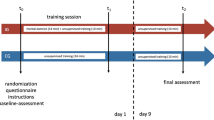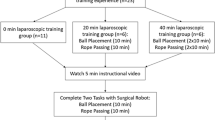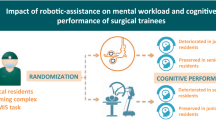Abstract
Background
It has been postulated that increased operator workload during task performance may increase fatigue and surgical errors. The National Aeronautics and Space Administration—Task Load Index (NASA-TLX) is a validated tool for self-assessment for workload. Our study aims to assess the relationship of workload and performance of novices in simulated laparoscopic tasks of different complexity levels before and after training.
Methods
Forty-seven novices without prior laparoscopic experience were recruited in a trial to investigate whether training improves task performance as well as mental workload. The participants were tested on three standard tasks (ring transfer, precision cutting and intracorporeal suturing) in increasing complexity based on the Fundamentals of Laparoscopic Surgery (FLS) curriculum. Following a period of training and rest, participants were tested again. Test scores were computed from time taken and time penalties for precision errors. Test scores and NASA-TLX scores were recorded pre- and post-training and analysed using paired t tests. One-way repeated measures ANOVA was used to analyse differences in NASA-TLX scores between the three tasks.
Results
NASA-TLX score was lowest with ring transfer and highest with intracorporeal suturing. This was statistically significant in both pre-training (p < 0.001) and post-training (p < 0.001). NASA-TLX scores mirror the changes in test scores for the three tasks. Workload scores decreased significantly after training for all three tasks (ring transfer = 2.93, p < 0.001, precision cutting = 3.74, p < 0.001, intracorporeal suturing = 2.98, p < 0.001).
Conclusion
NASA-TLX score is an accurate reflection of the complexity of simulated laparoscopic tasks in the FLS curriculum. This also correlates with the relationship of test scores between the three tasks. Simulation training improves both performance score and workload score across the tasks.





Similar content being viewed by others
References
Carswell CM, Clarke D, Seales WB (2005) Assessing mental workload during laparoscopic surgery. Surg Innov 12:80–90
Hart SG, Staveland LE (1988) Development of NASA-TLX (Task Load Index): results of empirical and theoretical research. In: Hancock PA, Meshkati N (eds) Human mental workload. North Holland Press, Amsterdam, pp 139–183
Peters JH, Fried GM, Swanstrom LL, Soper NJ, Sillin LF, Schirmer B, Hoffman K, The SFLSC (2004) Development and validation of a comprehensive program of education and assessment of the basic fundamentals of laparoscopic surgery. Surgery 135:21–27
Hart SG (2006) Nasa-task load index (NASA-TLX); 20 years later. In: Proceedings of the human factors and ergonomics society annual meeting, vol 50, pp 904–908
Yurko YY, Scerbo MW, Prabhu AS, Acker CE, Stefanidis D (2010) Higher mental workload is associated with poorer laparoscopic performance as measured by the NASA-TLX tool. Simul Healthc J Soc Simul Healthc 5:267–271
Zheng B, Jiang X, Tien G, Meneghetti A, Panton ON, Atkins MS (2012) Workload assessment of surgeons: correlation between NASA TLX and blinks. Surg Endosc 26:2746–2750
Young G, Zavelina L, Hooper V (2008) Assessment of workload using NASA task load index in perianesthesia nursing. J PeriAnesthesia Nurs 23:102–110
Prabhu A, Smith W, Yurko Y, Acker C, Stefanidis D (2010) Increased stress levels may explain the incomplete transfer of simulator-acquired skill to the operating room. Surgery 147:640–645
Yamaguchi K, Kanemitsu S, Kitakyushu Surgical Study G (2011) Surgeons’ stress from surgery and night duty: a multi-institutional study. Arch Surg 146:271–278
Tien T, Pucher PH, Sodergren MH, Sriskandarajah K, Yang GZ, Darzi A (2015) Differences in gaze behaviour of expert and junior surgeons performing open inguinal hernia repair. Surg Endosc 29:405–413
Carswell CM, Lio CH, Grant R, Klein MI, Clarke D, Seales WB, Strup S (2010) Hands-free administration of subjective workload scales: acceptability in a surgical training environment. Appl Ergon 42:138–145
Author information
Authors and Affiliations
Corresponding author
Ethics declarations
Disclosures
Drs Jesse Hu, Lu Jirong, Tan Wee Boon and Davide Lomanto have no conflicts of interest or financial ties to disclose.
Rights and permissions
About this article
Cite this article
Hu, J.S.L., Lu, J., Tan, W.B. et al. Training improves laparoscopic tasks performance and decreases operator workload. Surg Endosc 30, 1742–1746 (2016). https://doi.org/10.1007/s00464-015-4410-8
Received:
Accepted:
Published:
Issue Date:
DOI: https://doi.org/10.1007/s00464-015-4410-8




